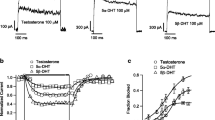Abstract
Reduction of an inwardly rectifying K+ current by thyrotropin-releasing hormone (TRH) and caffeine has been considered to be an important determinant of electrical activity increases in GH3 rat anterior pituitary cells. However, the existence of an inwardly rectifying K+ current component was recently regarded as a misidentification of an M-like outward current, proposed to be the TRH target in pituitary cells, including GH3 cells. In this report, an inwardly rectifying component of K+ current is indeed demonstrated in perforated-patch voltage-clamped GH3 cells. The degree of rectification varied from cell to cell, but both TRH and caffeine specifically blocked a fraction of current with strong rectification in the hyperpolarizing direction. Use of ramp pulses to continuously modify the membrane potential demonstrated a prominent blockade even in cells with no current reduction at voltages at which M-currents are active. Depolarization steps to positive voltages at the maximum of the inward current induced a caffeine-sensitive instantaneous outward current followed by a single exponential decay. The magnitude of this current was modified in a biphasic way according to the duration of the previous hyperpolarization step. The kinetic characteristics of the current are compatible with the possibility that removal from inactivation of a fast-inactivating delayed rectifier causes the hyperpolarization-induced current. Furthermore, the inwardly rectifying current was blocked by astemizole, a potent and selective inhibitor of human ether-á-go-go -related gene (HERG) K+ channels. Along with other pharmacological and kinetic evidence, this indicates that the secretagogue-regulated current is probably mediated by a HERG-like K+ channel. Addition of astemizole to current-clamped cells induced clear increases in the frequency of action potential production. Thus, an inwardly-rectifying K+ current and not an M-like outward current seems to be involved in TRH and caffeine modulation of electrical activity in GH3 cells.
Similar content being viewed by others
Author information
Authors and Affiliations
Additional information
Received: 15 May 1997 / Received after revision and accepted: 24 July 1997
Rights and permissions
About this article
Cite this article
Barros, F., del Camino, D., Pardo, L. et al. Demonstration of an inwardly rectifying K+ current component modulated by thyrotropin-releasing hormone and caffeine in GH3 rat anterior pituitary cells. Pflügers Arch 435, 119–129 (1997). https://doi.org/10.1007/s004240050491
Issue Date:
DOI: https://doi.org/10.1007/s004240050491




